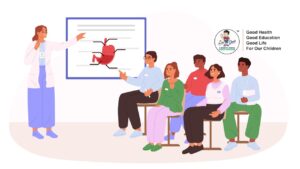Health awareness programs in schools involve all members of the school community and focus on understanding people’s feelings and needs. They promote positive social interactions and development, self-esteem enhancement, and academic guidance; students also have an opportunity to express themselves freely within an anonymous setting.
Health awareness programs in schools Health Services encompass medical consultation and referral, nursing care, and counseling/guidance/mental health support. District policies and administrative guidelines demonstrate our dedication to effective school-community partnerships.

Myhealthygenie is a comprehensive school health program
Health awareness programs in schools aim to promote and protect students’ physical, social, emotional, and mental well-being by supporting school food and nutrition services as well as worksite health promotion activities and community involvement programs. The American School Health Association has developed guidelines that outline all components necessary for an effective school health program; using these can assist schools with planning and implementation as well as measuring its success.
Health awareness programs in the schools environment provide students and staff members with a safe learning environment free from threats to the student or staff safety and include safe buildings, clean air, and water sources, no drugs or violence as well as the encouragement of family involvement as well as respect for cultural, linguistic and socioeconomic diversity of its inhabitants.
The school environment fosters student participation while teaching positive social skills and self-esteem. Students are encouraged to collaborate on solving problems or resolving conflict openly within limits of privacy, without resorting to physical confrontation. A crisis response system is available for student or staff emergencies such as suicide attempts, unintentional injuries, or deaths.

Counseling, guidance, and mental health services are provided to minimize inappropriate student behaviors and facilitate optimal school-related learning. Staffed by certified/licensed counselors, psychologists, and social workers – along with school nurses and physicians -, counseling guidance and psychosocial service staff effectively meet student needs: counselor-student ratio is 1:250 while psychologist-student ratio stands at 1:1000 while social worker-student ratio stands at 1:800.
Health awareness programs in schools Health services staff provides routine healthcare for all students, such as immunizations and vision and hearing screenings. A school-based clinic staffed by nurse practitioners and physician assistants who can write prescriptions, diagnose illnesses such as strep throat and manage chronic health conditions like asthma is available as part of this service; an accompanying dental program employing dentists and hygienists complements it all nicely.
The school food and nutrition program is founded on sound nutritional principles with the aim of increasing physical activity levels among school-aged children while encouraging healthier diets. School meals are overseen by a registered dietician, while all grade K-5 students receive nutrition education lessons as part of this model public health initiative.
Read:- Audiometry Test In School
Physical Activity

Children who are more physically active have lower rates of obesity in childhood and a lower risk of obesity and chronic medical conditions throughout their life. They also have better cognitive function and are more likely to score higher on verbal and mathematics tests. In addition, they are more likely to be active participants in the community and live longer healthier lives.
Physical activity is also a key component to reducing stress and improving learning. Research shows that even a single session of moderate to vigorous physical activity can improve cognition, executive function, attention, and academic performance. In addition, a good night’s sleep is improved by regular physical activity, and a student who is fully rested and awake will be more attentive in the classroom.
Incorporating daily recess, more physically active classroom lessons, more frequent and/or longer physical education classes, and before and after-school activities all can provide youth with the opportunity to reach the recommended amount of physical activity each day. Especially in schools with marginalized youth, such as those from low-income families, communities of color, or immigrant communities, increasing physical activity is essential to improving their health and well-being.
Health awareness programs in schools promoting strives to provide a safe and supportive environment, health-related curricula and services, food and nutrition programs, opportunities for physical education and recreation, health promotion programs for staff, and family/community involvement. In addition, the health-promoting school supports and encourages staff to model a healthy lifestyle and is committed to continuous improvement in its capacity as a health-promoting setting for living, learning, and working. It also strives to develop partnerships with other school-based, community, and public health agencies to foster collaboration in making the local community a safer and healthier place.
Personal Hygiene

A variety of personal hygiene programs can be promoted in schools, from basic handwashing to dental and oral health. This type of program is important because it can help children to avoid the development and spread of diseases such as diarrhea, typhoid fever, respiratory infections, sexually transmitted disease, and hepatitis A and B. This is especially true for young children, whose immune systems are not yet fully developed and mature.
Staff development and in-service programs address relevant health issues and instructional strategies. District policies and administrative guidelines reflect quality assurance and accountability for an effective health services component. A comprehensive plan exists to coordinate health services with other school and community programs. An interdisciplinary/interagency school health coordinating council includes school staff, students, and members of the community who represent all segments of the community.

